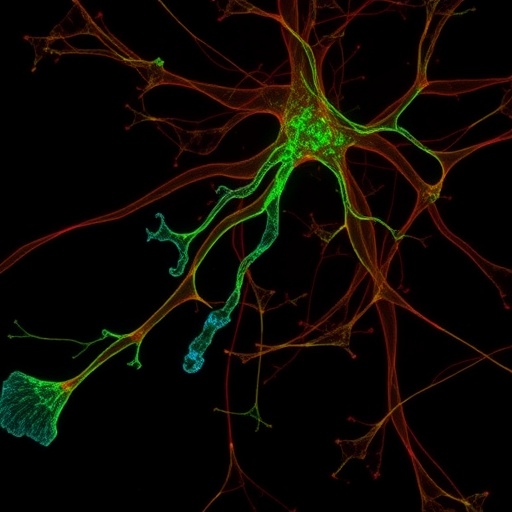Cells carry within them a remarkable and intricate blueprint encoded in DNA, a molecular instruction manual that dictates the proteins they produce and, consequently, their function. While the DNA sequence remains consistent across various cells in an organism, the way this genetic code is read and implemented varies dynamically. This variability is often governed by subtle but powerful signals in the form of chemical modifications, influencing DNA, RNA, and protein behavior, thereby shaping cellular identity and function.
A groundbreaking study recently published in Stem Cell Reports by researchers at the University of Michigan delves into the complex biochemical signals that govern the differentiation of stem cells into retinal cells. This research sheds new light on the epigenetic and epitranscriptomic mechanisms that refine how cells read their genetic blueprints to specialize, offering promising insights for regenerative medicine, particularly in therapies targeting retinal diseases.
At the core of this investigation lies a protein called METTL3, known for its role in adding methyl groups—a type of chemical modification—to RNA molecules. Such methylation is a critical regulatory mechanism that influences RNA stability and translation efficiency, directly impacting protein production. Previous studies have implicated RNA methylation in various diseases including diabetes and cancer, but its specific role in directing stem cell fate toward retinal development was unexplored until now.
The team utilized advanced genetic tools to either eliminate METTL3 or engineer versions of the protein incapable of RNA methylation. Intriguingly, the absence or functional impairment of METTL3 dramatically hindered the formation of retinal cells from stem cells. This dependency highlights the essential nuclear activity of METTL3 during retinal lineage commitment, suggesting that RNA methylation plays a pivotal part within the nucleus to orchestrate gene expression tailored for retinal development.
To map the precise RNA targets affected by METTL3, the researchers employed an innovative technique named GLORI (Global RNA Interactome Mapping), enabling high-resolution identification of methylation sites across the stem cell transcriptome. Through this mapping, they pinpointed key regulatory modifications on RNA molecules involved in retinal differentiation pathways, notably on Six3, a gene encoding a critical transcription factor that drives the stem cell-to-retina developmental switch.
Further experimentation demonstrated that these RNA methylations modulate the stability of Six3 transcripts. By deploying an RNA-specific CRISPR editing system, modifications situated at the 3’ terminus of Six3 RNA were found to be especially influential in controlling transcript stability. This fine-tuning directly affects the gene’s protein output, reinforcing the concept that RNA chemical modifications serve as sophisticated regulators of gene expression during retinal cell formation.
Beyond METTL3, the study also identified the Ythdf family of genes as essential mediators of this epitranscriptomic regulation. Inhibiting the expression of these genes mimicked the retinal development blockade observed with METTL3 loss, suggesting that the Ythdf proteins function as readers of methylated RNA, translating chemical marks into functional outcomes that promote retinal cell differentiation.
This research pioneers the exploration of RNA epigenetics in the context of retinal development, unraveling a previously unappreciated layer of gene regulation. By uncoupling chromatin accessibility from transcriptional output, METTL3’s RNA methylation activity delicately choreographs the progression from multipotent stem cells to specialized retinal tissue. These findings pave the way for new therapeutic avenues in retinal disease, where defective cellular differentiation or degeneration remains a major clinical challenge.
Intriguingly, the team uncovered that METTL3 modulates RNA without inducing changes in chromatin structure—an unexpected observation that challenges prevailing paradigms linking epigenetic modifications on chromatin with transcriptional control. This decoupling phenomenon suggests a unique intracellular mechanism by which RNA methylation exerts selective control over developmental gene expression programs without altering DNA accessibility.
Moreover, the researchers are now investigating how metabolic conditions, such as elevated glucose levels common in diabetes, influence RNA methylation patterns. Given the retina’s vulnerability to metabolic stress and the known damage caused by diabetes, understanding the interplay between metabolic states and RNA epigenetics could unlock vital clues to preventing or ameliorating diabetic retinopathy and other retinal disorders.
The implications of this study extend beyond developmental biology, offering a molecular foundation for stem cell-based regenerative therapies and precision drug screening for retinal diseases. By targeting the enzymes and pathways governing RNA methylation, future interventions may enhance the efficiency of generating retinal cells in vitro and develop strategies to maintain retinal health in disease states.
In summary, the University of Michigan study represents a landmark in elucidating how chemical modifications on RNA function as master regulators in stem cell differentiation toward retinal cells. The elucidation of METTL3’s role and its downstream effectors not only deepens our understanding of retinal development but also spotlights RNA epigenetics as a promising frontier in regenerative medicine and ophthalmic research.
Subject of Research: Cells
Article Title: METTL3 Uncouples Chromatin Accessibility from Transcription during Retinal Development
News Publication Date: 23-Oct-2025
Web References:
https://doi.org/10.1016/j.stemcr.2025.102690
References:
“METTL3 Uncouples Chromatin Accessibility from Transcription during Retinal Development,” Stem Cell Reports. DOI: 10.1016/j.stemcr.2025.102690
Keywords: Health and medicine, Life sciences




